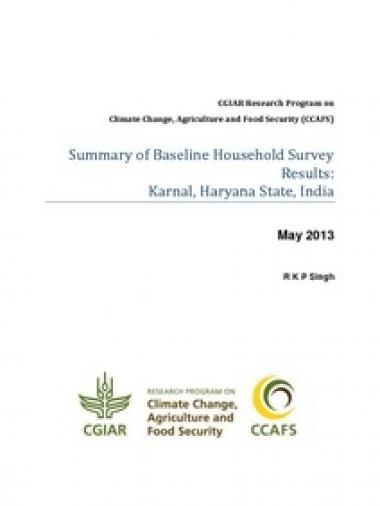Summary of baseline household survey results: Karnal, Harayana State, India

This report presents a summary of the main results of a survey carried out between November - December 2012 in 7 villages with 140 households (HHs) in Karnal, a benchmark site of the CGIAR Research Program on Climate Change, Agriculture, and Food Security (CCAFS)1. Karnal is located in Haryana State in north west India. The survey was carried out using the standardised CCAFS household baseline tool.
The results show that the majority of the surveyed households in the area are male-headed and less than 3% are female-headed, with an average of 6 persons per household. Most of the surveyed households belong to the forward castes (79%), followed by scheduled castes (11%) and other backward classes (9%). Almost all households (98%) have someone who obtained some level of education, and four out of ten households have a member who has attained post-secondary education.
There are a variety of livelihoods present in the surveyed area. Most of the household have integrated farming systems, integrating crops with livestock. Households produce food crops, livestock, fodder and vegetables, in general. Only 2% of the households were subsistence farmers, producing food and livestock only for their subsistence and not selling any products in the market. A majority of the households produced several products on the farm (5 to 8 products) and many households sold their products in the market irrespective of the number of products they produced last year.
The most important crops in Karnal are wheat, rice, and fodder and the most important livestock are buffaloes and crossbred cows. Fertilizer use in the area is very high. For our surveyed households only 1% face food shortages in an average year. Ninety percent of the households have made changes to their crops and cropping practices in the past 10 years as a result of market and climate -related reasons, and 94% have made changes in livestock and animal keeping practices.
The television is the major source of weather and climate related information in the area. This information in most cases is received by men. The most changed aspects of farming upon receipt of all the information were land management and change in crop/variety.
Karnal is a prosperous area and most of the surveyed households fall in the high asset ownership category of the asset index created. Almost all households own cell phones, televisions and electric fans.
Citación
Singh RKP. 2013. Summary of baseline household survey results: Karnal, Harayana State, India. Copenhagen, Denmark: CGIAR Research Program on Climate Change, Agriculture and Food Security (CCAFS).